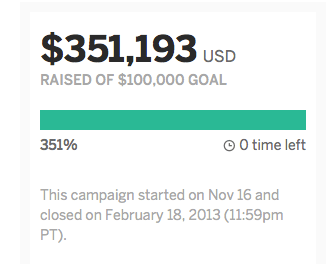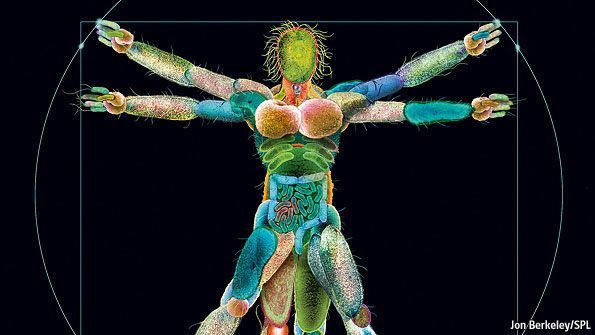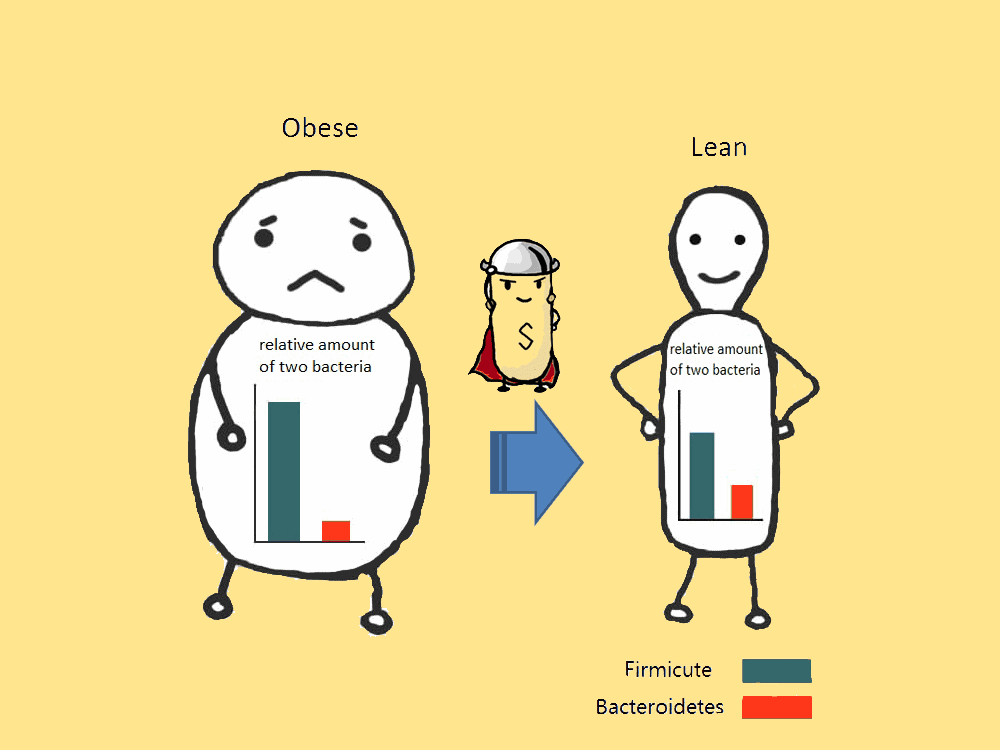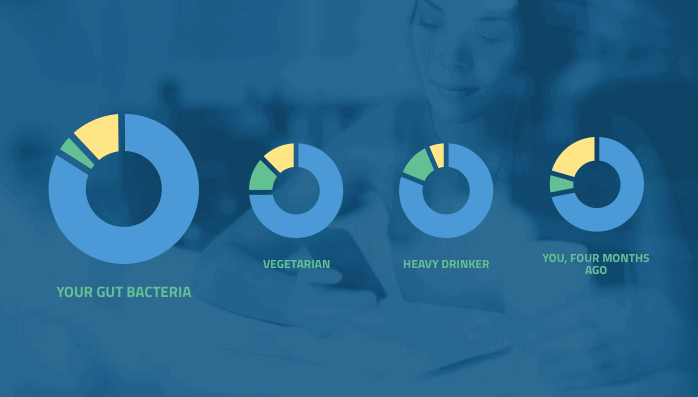Discover Your Microbiome With The uBiome Test [no longer available]
The uBiome test is no longer available, but read on to learn more about the importance of your microbiome… What lives on and in you is ten times more numerous than your cells, and can profoundly influence your health without you having the slightest idea of their existence? There are surprises ahead, so go read and watch some video for a few minutes.
THIS MORNING on the phone, my friend Riley was telling me about this hot new iPhone app development company that just hired him. After I peppered him with a dozen questions, he asked me one. It was a simple question, the answer to which evoked a slew of poop jokes.
“So, what are you doing today, Joe?”
“The usual Saturday extravaganza — writing a blog post.”
“Yeah, right… what’s the topic?”
“Microbiota.”
“What! Isn’t that some sorta poop!”
“Some sorta.”
(Stage left — poop jokes.)
It was at that moment, dear reader, that my challenge with this article appeared to me in three parts.
I will need to:
- Explain what microbiota is and why it’s so important;
- Keep you from clicking away immediately after encountering the “Yuk Factor”; and
- Convince you to get your microbiota evaluated.
(No, no, no… don’t click away yet!)
Right at this moment you may feel that you have no connection to “microbiota”.
Couldn’t care less if you ever hear the word again.
That attitude suits them fine. They don’t give a damn about your apathy or your neglect. Because they out number you, and they’re in control.
You know what an ecosystem is, yes?
Well, we humans basically dominate our ecosystem, for ill or good. We’re the dominant species in it.
But guess what?
Each one of us is also an ecosystem, the comfy home to trillions of critters, and they dominate us in ways you have yet to imagine.
These critters can make you sick or hale.
These critters can influence what you eat.
These critters may be able to make you depressed.
And you had no idea that they even exist, not in such multitudes or influence. Until now.
Listen up: If you’ve had some long and lingering ailment and no one seems to know why it exists and what to do about it, could be that your microbiota needs a make over.
Seriously. Keep reading…
This article covers the following:
- How bacteria can have a profound influence over us, good and bad.
- The story of uBiome, from successful crowdfunder to your venture capital backed microbiota analyzer.
- Why and how you should find out if your microbiota is working for you or against you.
Puppet Mastery
When I was a junior in college back in the days when two-cell organisms first started to emerge, a next door neighbor studying microbiology wrote a term paper he called The Fungus Among Us, something I still chuckle about.
Little did we know then that the fungus among us pales in comparison by number and influence to the microbiota on and inside us.
These critters are on our skin, in our nose, mouth, genitals, and, of course, our guts.
And, there are more of them than us.
A lot more.
It’s estimated that there are 10 times more bacteria in and on you than cells that are you. That’s about 100 trillion bacteria and other microbes collectively referred to as your “microbiome”.
There are various articles on this site that discuss how our mindset and psychology colors the world we see and engage. We have articles that evaluate the importance of hormone balancing to maintain (or regain) youthful vigor and health. We delve into diet and supplements that can help us get leaner. And we examine how important exercise is to maintain lean body mass (muscle) and youthfulness.
There’s something else, though, that’s going on. Something not us, per se, but that through some symbiotic dance can influence what we want to eat and our mood, how we respond to certain foods and each other.
This is the realm of our microbiota, and the bottom line is:
You need to know if yours is working for you or against you.
Let’s begin our journey with a summary of a very good New York Times article on the subject, Our Microbiome May Be Looking Out for Itself by Carl Zimmer.
Among several, Mr. Zimmer makes two observations in his article that I want to share (laced with some of my own observations):
1. Your Critters May Be The Puppet Master
The microbes on and within us have the means, motives and opportunities to manipulate its unwary ecosystem that is us. You may scoff at such an idea, but there are plenty of examples of parasites controlling their hosts.
Take for instance that aforementioned fungus. Some species of fungi, Mr. Zimmer points out,
“infiltrate the brains of ants and coax them to climb plants and clamp onto the underside of leaves. The fungi then sprout out of the ants and send spores showering onto uninfected ants below.”
How this happens is not quite understood, but may involve the release of molecules that can influence the brain, and our microbiome might be able to do something similarly.
For instance:
In our guts, bacteria make some of the same chemicals that our neurons use to communicate with one another, such as dopamine and serotonin. And the microbes can deliver these neurological molecules to the dense web of nerve endings that line the gastrointestinal tract.
A number of recent studies have shown that gut bacteria can use these signals to alter the biochemistry of the brain. Compared with ordinary mice, those raised free of germs behave differently in a number of ways. They are more anxious, for example, and have impaired memory.
Adding certain species of bacteria to a normal mouse’s microbiome can reveal other ways in which they can influence behavior. Some bacteria lower stress levels in the mouse. When scientists sever the nerve relaying signals from the gut to the brain, this stress-reducing effect disappears.
2. Your Puppet Master May Influence What You Eat, etc., etc.
What about food?
Who do you think chooses what you eat and drink?
Could be that bacteria can influence what their hosts eat (that would be you) and alter the levels of hormones that govern appetite. The microbes have an incentive to influence what we eat, because what we eat could result in them flourishing or dying.
Different species of microbes need different kinds of food. If they can somehow induce us to eat more of the food upon which they thrive, they can become strong and multiply.
But it can go the other way too.
Perhaps we can manipulate them for our own benefit. For example, we might eat various synbiotics (pre and probiotics) that would make us crave healthy food. Yogurt, kiefer and sauerkraut are three examples. (Read, How To Feed 100 Trillion Guests.)
If acting as the silent puppet master influencing what we eat was not enough, as you’ll soon discover, there’s a lot more that our microbiota affects.
One creepy observation, for instance: A mother’s vaginal microbiota will change before birth to have more milk digesting microbes. Moreover, the bacteria species will be different if the birth is by Cesarian section or vaginal delivery.
No kidding.
Introducing uBiome
UPDATE: uBiome is out of business. Do read the rest of this article to learn more about the importance of your microbiome and how to take care of it, but references to uBiome may be disregarded.
Now that you know that you might NOT be completely in the captain’s seat of your own destiny, wouldn’t it be good to discover who is the back seat driver?
uBiome wants to tell you.
After the National Institute Health (“NIH”) did some of the upfront heavy lifting, uBiome burst onto the scene with it’s Indiegogo crowdsource funding.
The NIH ran it’s Human Microbiome Project from 2007 thru 2012. It spent $173 million to sequence the genomes (genetic material of an organism) of 240 healthy individual humans with the aim of establishing a set of controls. NIH developed the technology to accomplish this.
Then came along uBiome, and they perfected the technology, and make it cheaper and available to everyone.
Late in 2012, they burst upon the scene with an Indiegogo crowdsourcing project, and — as they say — never looked back.
As the “World’s FIRST citizen science project to sequence the human microbiome”, uBiome raised $351,193, which was 351% above their $100,000 goal.

Not only the “world’s first”, but uBiome wound up being the most successful crowd sourced citizen science project in history:
2,500 participants in 40 countries, more than ten times larger than NIH managed to do.
Here’s the fun and informative video that helped knock the skin off the ball:
The uBiome test is not a diagnostic test.
In fact, the company asks anyone who writes about it to present this disclaimer:
“uBiome is not a diagnostic test. It can give you valuable information about what is in your microbiome and how it correlates with others. The information is for research purposes only.”
What it does is to show how your microbiome correlates with those of others, and that’s why this “citizen science” bit is so important.
Your critters are the data, and uBiome needs that data from as many people from as many walks of life as possible.
The more people get their microbiota sequenced, the better scientists can learn what species influence what aspects of our lives. The fantastic thing about this is, unlike our genetics which is fixed, our microbiome can change, and with it our health can be improved.
{Note: your genes are what they are, but how they’re expressed can be influence by behavior — read a bit about Epigenetics.}
As the good folks at uBiome wrote for their Indiegogo campaign:
The microbiome may be as important to human wellness as the human genome, but unlike the genome, you can change your microbiome. Because of this amazing potential, understanding the microbiome has become one of the most important scientific inquiries of our time. What are all these microbes and how do they affect us?
We’re just beginning to learn the effects our microbiome has on us, but one thing is very clear: it’s incredibly important to functioning of the human body. Certain species help digest food; some synthesize vitamins; others guide the immune system. Over a third of the bioactive molecules in our blood are produced by microorganisms. These molecules are things like caffeine, alcohol, aspirin, drugs, hormones, and neurotransmitters. They have potent effects on every aspect of our metabolism and behavior.
Researchers have correlated diabetes, obesity, heart disease, tooth decay, chronic sinusitis, depression, and anxiety to diverse organisms within the microbiome. You have a different microbiome in your mouth, your sinuses, your ears, your gut, your genitals, and on your skin. Often, it’s not the individual species that matter but the diversity of the ecosystem. Just as the ecosystem of the tropical rainforest depends upon diversity, our own microbiome appears to benefit from the presence of a wide range of beneficial microbes.
The uBiome Tests
>>No longer available <<
I’ve been meaning to get my microbiome tested ever since I learned about uBiome about a year ago. But I guess I had to get myself warmed up.
I wrote a two-part series on the subject:
- Can The Right Gut Bacteria Fight Obesity and Slay Metabolic Syndrome? (Part 1/2), and
- How Gut Bacteria Increase The Chance You’ll Suffer From Metabolic Syndrome and A Simple Solution (Part 2/2)
Yesterday, 3,100 words later, I finally got my butt in gear, went to uBiome’s website and ordered a kit.
How To Do The uBiome Test
You order a kit online, and it gets mailed to you wherever you live on the planet.
You’ll have three tests to choose from:
- The “Gut Kit” samples one site, that of your gut bacteria (one and provides comprehensive picture of how your microbiome changes over time and compares to other lifestyles.
- The “Gut Plus Kit” samples two sites, your gut and another site of your choosing, the list of which is up next in the third option.
- The “Five Site Kit” samples all five sites, gut, mouth, nose, genitals and skin — all those fine places your very own critters like to hide out. With this kit, you get a complete picture of the inner working of your entire body, of which “you” (as you now know) are a minor part.
Follow the simple instructions to swab and submit your microbiome to uBiome.
Which brings me back to my conversation with my friend Riley:
“So, Joe, how exactly does one get the sample to send to uBiome?”
He continues:
“I’m thinking there’s a yuk factor here.”
I explained to him that you merely do just do what you usually do after you poo, but with one extra step. You wipe yourself and then dab the Q-tip looking thingie sent in your kit onto the just-used toilet paper, then put it into a container of some odor-eliminating, microbe-preserving liquid and your done.”
(Riley chuckles.)
The Survey
There’s one more thing you need to do for the uBiome test, and that’s to answer a survey.
The online survey lets you ask and answer questions about your health and lifestyle. This is very important because you can then learn about how your results correlate with others who have had their microbe DNA sequenced.
The uBiome test results will tell you how you correlate to other users, to existing peer-reviewed studies, and to your previous samples should this become habit forming.
Your uBiome Results
>No longer available <<
Your test results will be sent to you, and you’ll receive a website login where you can visualize and comprehend the data. Everything’s safely stored and private.
A former girlfriend of mine used to say that “comparisons are odious”, but the creatures about whom she was referring are far larger than the subjects at hand.
In this case, comparisons are precisely what we seek. The tests are not (yet) diagnostic, but what they can do is let us compare our microbiota with that of others, as related to a set of health and lifestyle considerations.
Scientists have made important discoveries about how the composition of the microbiome relates to diseases like obesity, tooth decay, and chronic sinusitis.
This type of information will be provided to you and will help you…
- Determine how your microbiome compares with others,
Interpret the scientific literature, and - Empower you to understand the latest research about microbiomes similar to yours.
Data Visualization
Your personalized uBiome web account provides secure and easy access to your information. You will be able to design your own experiments. Find out how you compare to the healthy, vegans, paleo, overweight, heavy drinkers. And, if you get regular check-ups, you’ll be able to track how you compare to yourself over time.
Speaking of “visualization”, check out this video by DNews, which features interviews with some of the uBiome team and a tour of their lab:
Your Takeaway
If you’ve come this far you’ve learned that there’s more to you than meets the eye.
Yes, maybe your mother always said so, but in this case we’re not talking about your hidden personality.
What you are is an entire ecosystem for trillions of creatures you can not even see. Visible or not, they exist and can have a substantial impact on your well being, for better or worse
If you’re not yet convinced that this is true, read Can The Right Gut Bacteria Fight Obesity and Slay Metabolic Syndrome? (Part 1/2) and see if that is sufficiently persuasive to take you to Part 2.
I’ll be writing more on this topic down the road. As frequent readers know, I’ll be compelled to share my results, which then will perhaps provide you a map to guide your own adventures.
That’s it.
Adios!
Last Updated on September 29, 2022 by Joe Garma





